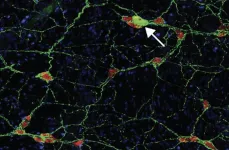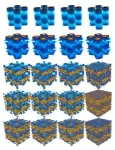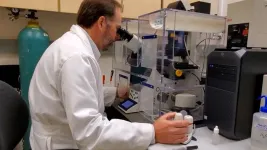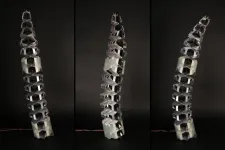(Press-News.org) NEW YORK, NY--Ask any neurologist: Parkinson’s disease is a brain disorder. The conspicuous symptoms of Parkinson’s disease—uncontrollable tremors, slowed down motions, and the feeling that one’s feet are stuck to the ground—all stem from the loss of neurons in a region of the brain that helps control movement.
But many researchers believe that the neurodegenerative disorder may get started far away from the brain—in the gut—and years before the first neurological signs appear.
New findings by Columbia researchers David Sulzer, PhD, and Dritan Agalliu, PhD, and two of their graduate students are adding to evidence backing this hypothesis—and showing that what triggers initial gastrointestinal changes in Parkinson’s could be a misdirected immune attack.
“If this is the beginning of Parkinson’s in many people, we could potentially identify who has the disease before it ever reaches the brain and hopefully stop it in its tracks,” Sulzer says. The new findings were published Aug. 18 in Neuron.
Autoimmunity and the gut
The gut-first theory of Parkinson’s, originally proposed 20 years ago, started to intrigue Sulzer after his own research pointed toward the role of an autoimmune response in Parkinson’s.
In Parkinson’s, a protein called alpha-synuclein becomes misfolded, accumulates inside neurons, and slowly poisons the cells. Sulzer’s lab in collaboration with immunologists at the La Jolla Institute of Immunology has shown that small portions of the misfolded alpha-synuclein also can appear on the outside of neurons, which makes the neurons vulnerable to attack from the immune system. The immune attack could be doing more acute damage to the neurons than the internal deposits of alpha synuclein.
“The blood of Parkinson’s patients often contains immune cells that are primed to attack the neurons,” Sulzer says, “but it’s not clear where or when they are primed.”
The gut was an intriguing possibility because it contains the same neurons and because most Parkinson’s patients experience constipation years before brain symptoms emerge and the disease is diagnosed. To pursue this hypothesis, Sulzer teamed up with Agalliu, a neuroimmunologist with expertise in mouse models of another neurological disorder (multiple sclerosis) that has autoimmune features.
Immune response to alpha synuclein leads to gut symptoms
To find out if an immune reaction to alpha-synuclein can kick-start the disease and where, Francesca Garretti and Connor Monahan, grad students directed by Agalliu and Sulzer, first created a mouse capable of displaying pieces of misfolded alpha-synuclein on cell surfaces (natural mice do not have this ability). They then injected the mice with alpha-synuclein and monitored what happened in the brain and the gut.
The researchers did not see any signs resembling Parkinson’s disease in the brain, but they did see that an immune attack on neurons in the gut produced constipation and other gastrointestinal effects resembling those seen in most Parkinson’s patients years before they are diagnosed with the disease.
“This shows that an autoimmune reaction can lead to what appears to be the early stages of Parkinson’s and is strong support that Parkinson’s is in part an autoimmune disease,” Sulzer says.
The findings also raise the possibility that early detection—and then interruption—of an immune response in the gut could prevent a later attack on the brain’s neurons and stop Parkinson’s in its tracks.
Wanted: A mouse with Parkinson's disease
Right now, though, it’s not clear how big a role the immune system plays in the Parkinson’s brain. The answer to that question may become clearer if the researchers find out why the brains of their mice did not develop any signs of Parkinson’s.
The team hypothesizes that the immune cells in their mouse model may not be reaching the brain because the animals are young and age has not yet weakened the blood-brain barrier sufficiently to let immune cells squeeze through. Opening the barrier or accelerating the aging process may lead to mice that develop gastrointestinal and brain symptoms.
“Our ultimate goal is to develop a model of Parkinson’s disease in mice that recreates the human disease process, which doesn’t exist right now,” Sulzer says. “That will be critical in answering questions about the disease that we can’t explore in people and eventually developing better therapies.”
Additional information
The results were published Aug. 18 in the journal Neuron in a paper titled "Interaction of an α-synuclein epitope with HLA-DRB1∗15:01 triggers enteric features in mice reminiscent of prodromal Parkinson’s disease."
All authors: Francesca Garretti (Columbia, now at Icahn School of Medicine at Mount Sinai), Connor Monahan (Columbia), Nicholas Sloan (Columbia), Jamie Bergen (Columbia), Sanjid Shahriar (Columbia), Seon Woo Kim (Weill Cornell Medicine), Alessandro Sette (La Jolla Institute for Immunology), Tyler Cutforth (Columbia), Ellen Kanter (Columbia), Dritan Agalliu (Columbia), and David Sulzer (Columbia).
This research was funded by Aligning Science Across Parkinson’s through the Michael J. Fox Foundation for Parkinson’s Research, the National Institutes of Health (grants R01NS095435, R01MH112849, and R01EY033994); the JPB Foundation; the National MS Society (RG-1901-33218), and gifts from Newport Equities LLC, the Walz family, and PANDAS Network to the Department of Neurology at Columbia University.
END
Study adds to evidence that Parkinson’s starts in the gut
2023-08-22
ELSE PRESS RELEASES FROM THIS DATE:
Mapping methane emissions from rivers around globe reveals surprising sources
2023-08-22
Freshwater ecosystems account for half of global emissions of methane, a potent greenhouse gas that contributes to global warming. Rivers and streams, especially, are thought to emit a substantial amount of that methane, but the rates and patterns of these emissions at global scales remain largely undocumented.
An international team of researchers, including University of Wisconsin–Madison freshwater ecologists, has changed that with a new description of the global rates, patterns and drivers of methane emissions from ...
Neuroscientists create new resource to improve Alzheimer’s disease research models
2023-08-22
INDIANAPOLIS – A new study by Indiana University School of Medicine researchers uses more genetically diverse mouse models to study the accumulation and spread of abnormal tau protein deposits in the brain—a known sign of Alzheimer’s disease and several other neurodegenerative diseases. The study’s findings, recently published in the Journal of Experimental Medicine, could lead to better research models that improve understanding of how different genetic backgrounds influence neurodegenerative disease development and treatment needs.
“As ...
Glitter impairs growth of organisms with key roles in aquatic ecosystems, study shows
2023-08-22
A study conducted by researchers affiliated with the University of São Paulo (USP) in Brazil concluded that particles of glitter can hinder the growth of organisms at the base of aquatic ecosystems, such as cyanobacteria (blue-green algae), which play a key role in the biogeochemical cycles of water and soil, as well as being eaten by other organisms. An article on the study is published in the journal Aquatic Toxicology.
Ubiquitous in makeup, nail polish, holiday decorations, greeting cards, Carnival costumes and many other places, glitter sticks to skin and clothes and requires a lot of effort to remove. It is made up of microplastics, tiny particles ...
Mount Sinai study identifies most effective and safest outpatient labor induction methods, potentially reducing hospital stays and increasing hospital efficiency in use of resources
2023-08-22
Paper Title: Outpatient cervical ripening and labor induction with low-dose vaginal misoprostol reduces the interval to delivery: A systematic review and network meta-analysis
Journal: American Journal of Obstetrics and Gynecology, July 2023
Authors: Joanne L. Stone, MD, MSHCDL, Professor and System Chair of the Raquel and Jaime Gilinski Department of Obstetrics, Gynecology and Reproductive Science at the Icahn School of Medicine at Mount Sinai; Rachel Meislin, MD, Maternal-Fetal Medicine Fellow at Mount Sinai Hospital; and other coauthors.
Bottom Line: While prior research and analysis have evaluated methods of outpatient labor ...
NIH awards The Texas Heart Institute $1.14 million to develop a novel, first-in-class drug for atherosclerotic cardiovascular disease
2023-08-22
HOUSTON (Aug. 22, 2023) — The National Heart, Lung, and Blood Institute (NHLBI) recently awarded The Texas Heart Institute® (THI) a two-year, $1.14 million grant to develop a novel, first-in-class drug to treat cardiovascular disease (CVD) as a significant improvement to current treatment regimens — specifically for adverse events arising from atherosclerosis.
Cardiovascular disease is the leading cause of death worldwide, with the Centers for Disease Control and Prevention (CDC) estimating that one person dies from CVD every 33 seconds in the United States, accounting for one in every five deaths in 2021.
CVD leads to heart ...
UT Health San Antonio, 7 collaborators garner $46 million from NIH to move discoveries into practice
2023-08-22
SAN ANTONIO (Aug. 22, 2023) — The University of Texas Health Science Center at San Antonio (also called UT Health San Antonio) and seven regional collaborators will leverage $46 million from the National Institutes of Health (NIH) over the next five to seven years to translate scientific discoveries into therapeutic benefits for human health and well-being.
A key focus will be reducing health disparities among Mexican Americans, active military personnel and veterans.
William L. Henrich, ...
Automate or informate? Firms must invest in specific types of IT to improve working capital management
2023-08-22
The management of working capital — or a firm’s current assets minus its current liabilities — aids organizations in making efficient use of their existing assets and maximizing cash flow.
The relationship between efficient working capital management and firm performance can be complex due to globally dispersed supply chains, number of suppliers and product variety, and technological uncertainty, among other factors.
New research from the University of Notre Dame shows that information technology represents a critical investment that ...
Stealth BioTherapeutics will spotlight latest advancements in mitochondrial medicine at Targeting Mitochondria 2023, Berlin
2023-08-22
BERLIN, Germany – Stealth BioTherapeutics, a front-runner in the world of mitochondrial medicine, is set to unveil its latest breakthroughs at the much-anticipated Targeting Mitochondria 2023 conference in Berlin this October.
Dr. David A. Brown, Vice President of Mitochondrial Research at Stealth BioTherapeutics, is slated to give an enlightening talk titled, “Translational insights from targeting mitochondria in rare diseases.” His presentation promises to provide insights into Stealth’s progress in clinical programs, with updates on their advancements in addressing rare mitochondrial diseases across several Phase 2/3 clinical trials. ...
MIT engineers use kirigami to make ultrastrong, lightweight structures
2023-08-22
Cellular solids are materials composed of many cells that have been packed together, such as a honeycomb. The shape of those cells largely determines the material’s mechanical properties, including its stiffness or strength. Bones, for instance, are filled with a natural material that enables them to be lightweight, but stiff and strong.
Inspired by bones and other cellular solids found in nature, humans have used the same concept ...
$1.7 million research project to examine how public schools identify learning disabilities
2023-08-22
A University of Houston researcher is launching a new study to examine how elementary schools across Texas and Florida identify specific learning disabilities in students, with the goal of improving processes so children with significant academic difficulties can succeed.
Jeremy Miciak, research associate professor of psychology at the University of Houston’s Texas Institute for Measurement, Evaluation, and Statistics, was awarded a $1.7 million grant from the National Center for Special Education Research at the Institute of Education Sciences, the research arm ...






